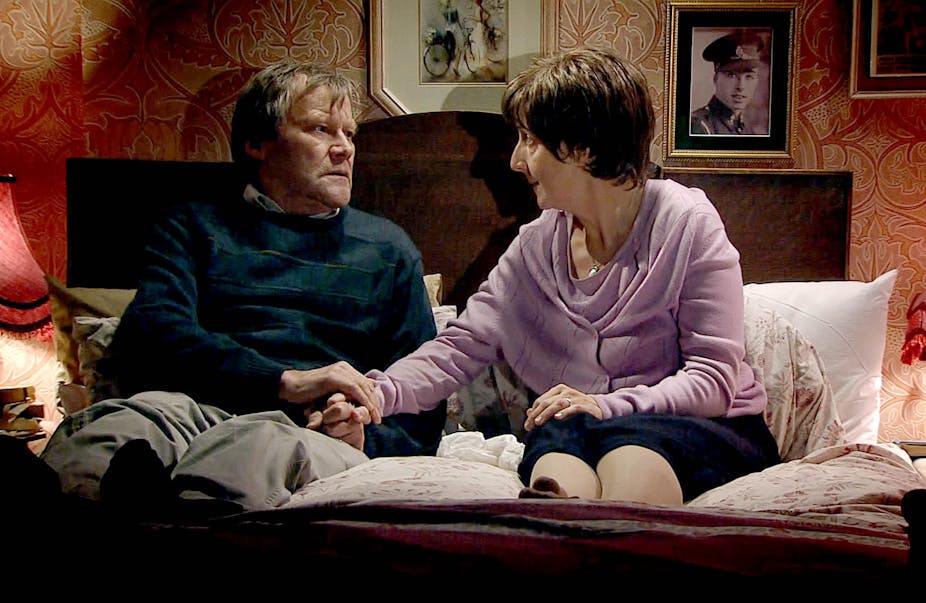Coronation Street’s Hayley Cropper killed herself before the watershed last night. The build up to this prompted the inevitable moral panic frenzy. The media’s role in the representation of suicide is certainly a sticky topic, with a sticky history.
It took years of campaigning from suicide prevention agencies before the newspaper Editors’ Code Committee agreed to advise that details of methods used should not feature in articles about people who take their own lives. Prior to that, the Press Complaints Commission had been sceptical about the risk of copycat behaviour, and even deemed publication by three national papers of pictures of a woman jumping to her death merely a matter of “taste”, and so beyond its jurisdiction.
Yet years before, in April 1999, The Sun had blamed the BBC for an apparent sudden rise in suicide attempts, after an episode of Casualty featured a painful death from a paracetamol overdose. The following week there had been a 17% increase in the number of people attending Accident & Emergency units declaring they had taken too much paracetamol. Yet the same newspaper would later publish an illustration of the complex machine constructed by a desperate young man with which he killed himself.
And of course many national papers became convulsed with the cluster of “Bridgend suicides” when 16 young people hanged themselves during a two-month period in 2007, causing the media to engage in some dangerous myth-making.
Since then, as the distinguished psychiatrist Keith Hawton told The Lancet in 2012, there have been great advances in the way the media have handled suicide. But he also warned:
Where you get a flurry of intense media activity — I’m thinking, for example, about the deaths of young people in Bridgend in the UK — then I think all the problems about public understanding of suicide tend to get disregarded.
There are more mature approaches than this frenzy. Monday night also saw rapper Professor Green present a Radio 1 programme called Suicide Survivors which discussed why so many young people display suicidal behaviour, and what can be done to discourage them from taking their own lives.
The journalism ethics charity MediaWise first investigated the media’s role in “suicide contagion” immediately after the 1999 Casualty episode. As is so often the case behind the scenes of dramatic representations of problematic behaviour, we discovered that a great deal of thought and research had gone into the storyline. It was part of a wider and successful “plot” to warn about the dangers of paracetamol misuse, and to educate the public about when it was appropriate to use A&E services. The press had got hold of the wrong end of a story that had positive consequences.
Meanwhile, Keith Hawton and his colleague Katherine Williams were reviewing research about the impact of media coverage on suicidal behaviour over the past 150 years in more than 20 countries. The evidence was clear: when details of suicide methods were publicised there was a tendency for copycat behaviour. Similar results were found when examining suicide trends in Asia and the Far East were investigated.
MediaWise developed concise but comprehensive international guidelines for print and broadcast journalists in consultation with suicide prevention agencies and journalists’ unions. However our later study revealed that unless journalists have had personal experience of suicide or been alerted to the issues during training they are unlikely to recognise the problem of copycat contagion or seek advice and guidance.
Yet there is plenty out there. The more heavily regulated broadcasters have long taken more care about representations of suicide. They also direct audiences to helplines. Samaritans were closely involved in the development of the Coronation Street storyline, and helplines are available for those who may be affected by the issues. How often do newspapers publish a helpline when reporting on suicides or inquest hearings?
But the biggest bugbear still remains, and is far more ingrained. This is the insistence on use of the term “committing suicide”. It is no longer a crime, nor should it be regarded as a “sin”. The media should not be squeamish about saying that people “kill themselves” or “take their own lives”.
It may seem too matter of fact but it is more accurate, and starting that debate is good way of getting people to confront the issues that lie behind the act – mental health issues, and emotional isolation. If the media helped people to recognise the causes of suicidal behaviour rather than romanticise or sensationalise the act itself, we might all be on the road to recovery.

